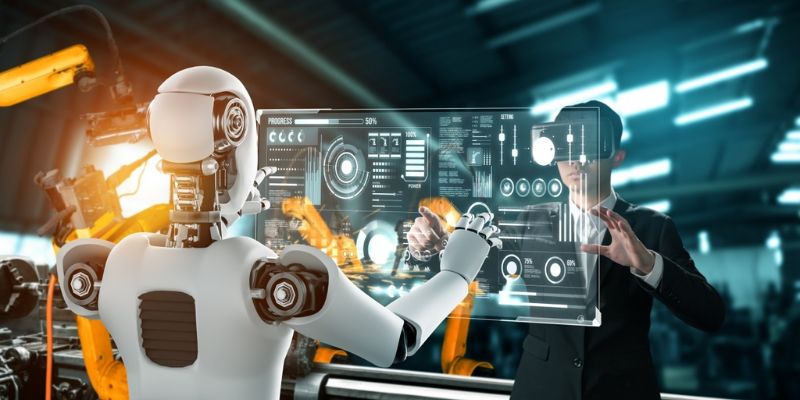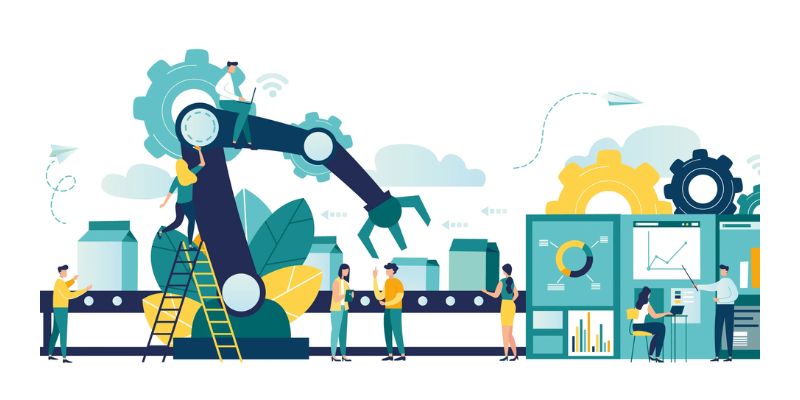The Future of Work: Embracing Automation Without Losing Jobs
What’s coming for your job? Here’s the reality: The future of work and impact of automation on jobs is a hot topic. Think robots and AI might take over your desk? You’re not alone. Everyone’s talking about how machines are changing the job game. I’m here to guide you through this tech shake-up. Together, we’ll learn what’s up with robots at work, and how you can stay ahead. This isn’t just about tech. It’s about making sure you keep thriving when computers and bots get smarter. Let’s dive in, figure it out, and make sure you’re set for the future.
Understanding the Current Landscape of Automation in the Workforce
The Real Impact of AI and Robotics on Job Automation Effects
Have you ever thought about robots at work? You might picture a factory where robots build cars. But today’s truth is bigger. Robots and AI are changing all kinds of jobs, not just in factories. Did you know that AI can change how doctors, bankers, and even farmers work?
Some folks get scared when they hear about robots at work. They think, “Will robots take my job?” The truth is, robots do take over some tasks. But they also make new jobs. Think of it like this: robots help us do the tough stuff, so we can do what we do best—think, create, and solve problems.
AI and robots can make some jobs easier or even safer. For example, a robot might go into a dangerous mine, so people don’t have to. Or AI can help doctors look at X-rays and find things they might miss.
But what about the jobs that robots take over? It’s not all bad news. When robots handle the boring tasks, people get to work on more interesting things. Like a bank worker who used to count money all day now gets to help customers solve financial problems.
Analyzing Employment Sectors Primed for Occupational AI Integration
Let’s talk about where AI fits into different jobs. Not every job will change the same way. There’s a lot of chat about ‘future workplace trends’. Jobs like making stuff, checking things, or entering data—these could change a lot because of AI.
But, there’s more to the story. Some jobs need a human touch. Jobs where you need to think different every day or use your heart, like nurses or teachers, won’t be taken over by robots so easy.
Also, some new jobs will come up that we can’t even think of yet. That’s pretty exciting! Companies that have fancy things like ‘predictive analytics’ can guess what skills we’ll need. This helps people get ready for new kinds of work.
It’s not just about what jobs robots will do, but how they’ll work with us. We call this ‘human-robot collaboration’. Picture this: a robot lifts something super heavy while a person tells it where to go. They’re a team!
Guess what? Workers today might need to learn new skills. It’s called ‘workforce upskilling’. This is when you learn new things to do your job better with robots around. You might learn to program robots or use new software.
Plus, ’employment sectors and AI’ are both changing a lot. Farms use drones to check crops, and shops use AI to figure out what people like to buy. Every job has something to gain from AI.
The ‘digital workplace evolution’ is also shaking things up. More people work from home now, and they use tech to stay connected. This change in ‘remote work advancements’ can mean less time in traffic and more time getting stuff done.
So, are robots taking all the jobs? Not really. They change jobs and make some new ones. With the right skills, we can work along with robots, not against them. The future of work means teaming up with tech to do things better than before. And that’s a future we can all look forward to.

Harnessing Technology for a Thriving Workforce
Essential Strategies for Workforce Upskilling and Reskilling for Future Jobs
We’re standing on the edge of a big change. Robots and AI are joining our teams. We can’t stop tech. But we can learn to work with it, and keep our jobs safe.
Upskilling means learning new skills for your current job. For instance, a bank teller learns to use new finance software. Reskilling, on the other hand, is about learning a whole new set of skills for a different job. Think of a factory worker training to be a tech support helper. Both these ways help us get ready for future jobs. And they keep us ahead of robots that can’t learn like we can.
Companies should help us learn. They need to spot the skills we will all need. Then, give us the tools to learn these skills. This could be online classes, in-office training, or even virtual reality. We should get time to learn during work hours, not just after. When we all grow our skills, the whole company does better.
The Role of Predictive Analytics in Shaping a Data-Driven Job Landscape
Now, let’s talk about how companies find out what skills we need. This is where numbers and data come into play. It’s called predictive analytics. It’s like a crystal ball, but with data. The data tells bosses what jobs are up-and-coming. And which ones might not be around much longer.
It doesn’t just guess. It looks at lots of info to make these calls. This can help people decide what they should learn next. Also, it helps schools and training programs know what to teach.
So, bosses use data to figure out what we should learn. And they can even use data to find the right person for a new job. That keeps everyone moving forward. When work changes, we change with it. And we can thank the data for pointing the way.
In the end, learning new things seems fun, right? Robots might be smart. But we have the power to learn and adapt. And that’s something no robot can match. When we join hands with tech, we can do amazing things and keep our jobs safe. We just have to be eager to learn and ready to change. That’s how we’ll make sure we still matter in a world full of smart machines.

Navigating Economic and Ethical Considerations of Automation
Exploring the Economic Outcomes of Automation and Potential for Universal Basic Income (UBI)
People often ask if robots will take our jobs. The short answer: they will change them. Robots and AI will do tasks we find hard, boring, or dangerous. This means we can focus on work that humans are best at, like creating, solving problems, and working with others. But it’s not all easy. Some jobs might get lost. This is where Universal Basic Income, or UBI, comes in.
UBI is a plan to give everyone a set amount of money, no matter what. It’s like a safety net. It helps us catch our breath and learn new skills if our jobs change because of tech. Some people think UBI is a good fix for job loss due to robots. Others say it costs too much or it’s not fair. Still, countries like Finland tried it, and it helped people stay happy and less stressed while looking for work.
Balancing Advancements and AI in the Workforce Ethics
Now, let’s chat about smart tech, like AI, in our jobs. AI can help us do our work better and faster. It sorts info, answers questions, and even helps make big decisions. But here’s a thing we need to think about: Is it always good? What if AI makes choices that are not fair to all people? We got to make sure AI behaves well.
We want tech to help us, not harm us. Think of it like this: a hammer can build a house or break a window. It’s the same with AI. We need to use it to build, not break. And the people who make AI must teach it to be fair and kind.
Yes, AI is changing how we work. But it also means we can do jobs we never thought of before. There will be new jobs in making AI, finding patterns in data, and checking if the AI is doing the right thing. People who do these jobs need to understand how tech works. They also need to know about the jobs that AI is helping with. This is why learning new stuff, called upskilling, and getting training for new jobs, called reskilling, are so important. We all need to keep learning, so we can work well with robots and AI.
In this new world of work, we can do great things. We can make work safer, easier, and more interesting. We can make sure there are jobs for people who want to work. And we can think about plans like UBI to help people when work changes. Most of all, we got to remember that tech and AI should help everyone and be fair to everyone. Let’s work together with robots and AI to make a good future for all of us.

Future-Proofing Jobs: Strategies for Human-AI Collaboration
Creating Synergy with Human-Robot Collaboration in Various Industries
Imagine a future where your coffee is made by a robot. But this robot doesn’t just work alone. It teams up with a human who picks the perfect beans and sets the mood with music. That’s human-robot teamwork. It’s happening in coffee shops, factories, and even hospitals!
Robots are good at tasks that are dull or dangerous. But they can’t replace the human touch in many jobs. So we bring people and robots together. We make a team that’s better than either could be on their own!
Now let’s talk about hospitals. Nurses can spend more time with patients. Why? Because robots help them do the heavy lifting. Or look at cars. Robots build them fast and with less error. But humans check the quality. They make sure the cars are safe for us all.
How does this happen? Through smart training and picking the right jobs for robots. We make sure people still have important work. And we train them to work with new tech. This way, jobs don’t get lost. They just change. They even become more fun or safer.
Preparing the Workforce for Digital Workplace Evolution and Remote Work Advancements
Work is changing, and not just in factories or coffee shops. Offices are changing too. More and more, people work from home. They talk to their teams online. This is remote work, and it’s getting big!
But what if your job is hard to do from home? This is where we get clever. We use new tech so you can work from anywhere. We make it easier to join meetings, share ideas, or even handle big data.
Now, let’s think about your skills. What if your job starts to fade away? We don’t let you fall behind. We help you learn new things. This is what we call upskilling. Or maybe you want a total change. Then we help you learn a whole new job. That’s reskilling. It’s like getting a fresh start!
This is how we make sure no one gets left out. We don’t want anyone out of work because of robots or new tech. By training you and helping you adapt, we keep you in the game. And this game is always changing. But don’t worry. We’re here to coach you through it.
To sum it up, the future of work is not robots taking over. It’s about them helping us do better. It’s about us growing and learning new things. And it’s about everyone having a spot in this future. So let’s welcome the change. Let’s work with robots, not against them. Let’s keep learning and stay ahead. That’s how we win in the future of work!
In this post, we’ve explored how automation is reshaping work. We’ve seen AI’s real impact and considered jobs ripe for AI use. We’ve tackled strategies for upskilling and the importance of data in job trends. We’ve weighed the economic effects and ethics of automation, as well as the potential for a Universal Basic Income. Finally, we’ve looked at how we can blend human and AI strengths in the workplace and adapt to digital changes.
As an expert in the field, I urge us to embrace these changes proactively. Equipping workers with new skills and fostering human-AI cooperation are vital steps. By doing so, we can ensure a robust, fair future for all in the evolving job landscape. Let’s use technology as a tool for growth, not a barrier. Together, we can build a work world that thrives on innovation and inclusivity.
Q&A :
How is automation expected to change the future of work?
With the rise of AI and robotics, automation is expected to significantly alter job markets. Tasks that are repetitive in nature are more likely to be automated, potentially leading to operational efficiency. However, this shift also demands a new skills paradigm where human workers need to adapt to more complex and creative roles that machines cannot easily replicate.
What types of jobs are most at risk due to automation?
Jobs that involve routine tasks, such as data entry, assembly line work, and basic customer service, are at a higher risk of automation. Advances in technology have enabled machines to perform not only manual labor but also some cognitive tasks, placing additional categories of jobs at risk, including some in the transportation, manufacturing, and retail sectors.
How can workers prepare for the impact of automation on their jobs?
To prepare for the impact of automation, workers should focus on lifelong learning and reskill accordingly. Emphasizing skills that are uniquely human, such as creative problem-solving, interpersonal communication, and emotional intelligence, can help maintain relevance in an automated workforce. Additionally, staying informed about industry trends and engaging in continuous professional development can offer competitive advantages.
Will automation create new job opportunities?
While automation may displace certain types of jobs, it also has the potential to create new opportunities. For instance, the development, maintenance, and oversight of automated systems will require a workforce skilled in areas like AI, machine learning, and robotics. Additionally, as productivity increases due to automation, new markets and sectors may emerge, further generating jobs that we may not currently foresee.
How could businesses evolve with the advancement of automation and AI?
Businesses are likely to undergo transformative changes with the advancement of automation and AI. They will need to reassess and potentially redesign workflows, job roles, and business models. Embracing these technologies can lead to increased efficiency and reduced operational costs. Companies that strategically integrate automation and human talent may gain a significant competitive edge by enhancing innovation and providing improved customer experiences.



